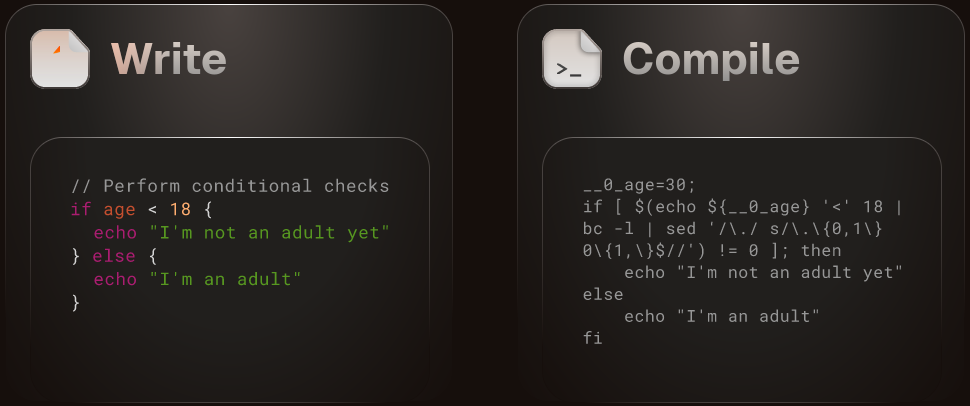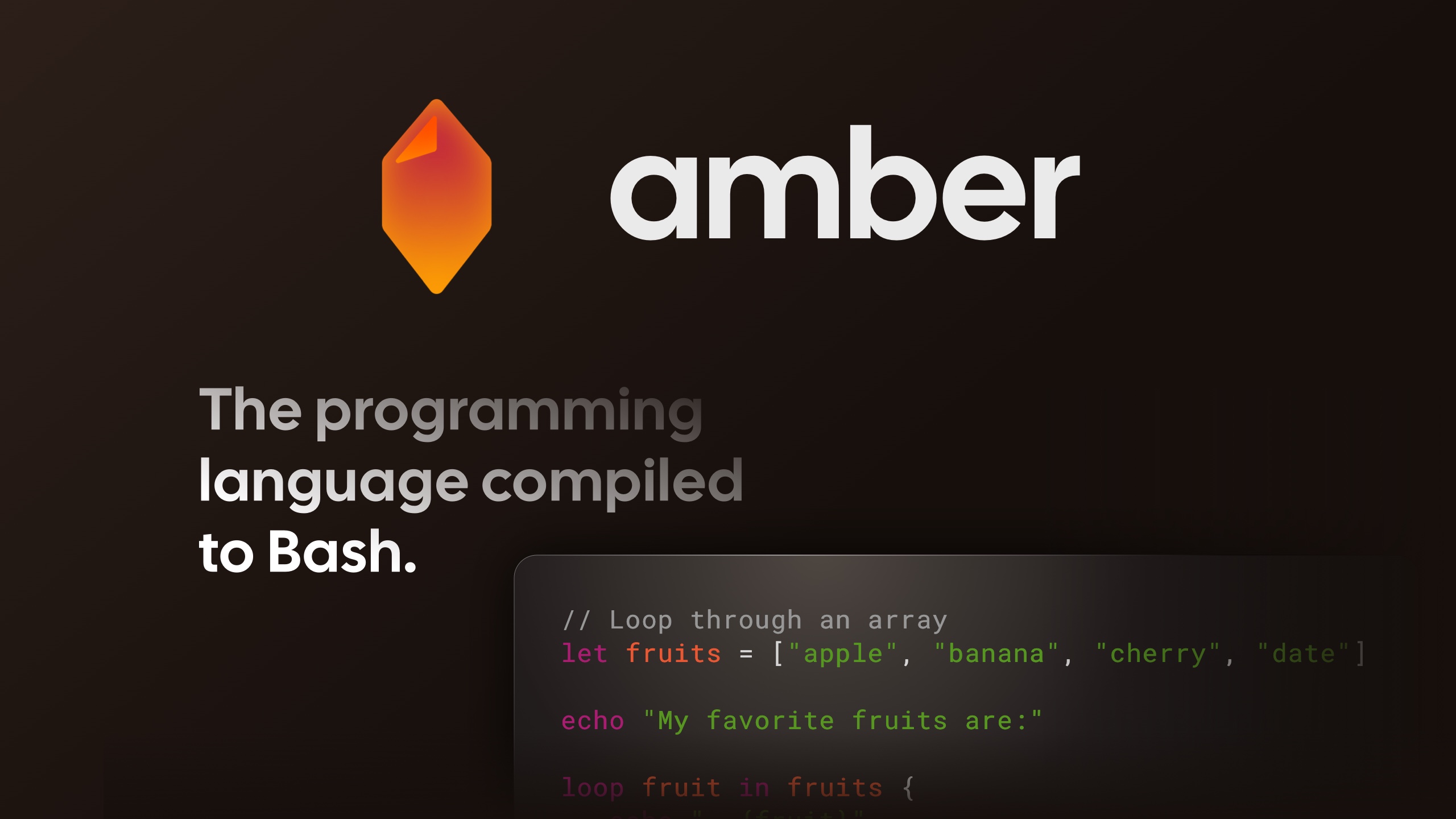- cross-posted to:
- programming@programming.dev
- cross-posted to:
- programming@programming.dev
New favorite tool 😍
let

What are you talking about?
The Javascript style syntax
letis also used to declare values in better languages than JavaScript, such as Haskell and ML family languages like OCaml and F#
About the
letkeyword, which is used to declare a variable.I thought so, but why do they object? Do they want Bash’s error-prone implicit variable declaration?
They, most probably, just didn’t like the name.
This is glorious.
I’m a mathematician with very limited programming experience. Can someone explain the significance of this?
Bash is one of the most used shell language, it’s installed on almost all Linux and Mac systems and can also be used on windows. Almost no one likes writing it as it is convoluted and really really hard to read and write. There are many replacement language’s for it, but using them is troublesome, because of incompatibilities. Amber is compiled which will solve problems with compatibility and it seems that language itself is very readable. On top of that it has most futures that modern programmers need.
Thank you, I think I understand now. 🙂
Basically dealing with abandoned-by-god syntax and limitations of bash. You can abstract them away!
Cool website
Just learn Bash lol
I’m trying but I’m shooting my own foot all the time 😢
It’s okay it’s filled with foot guns.
Looking at the example

Why does the generated bash look like that? Is this more safe somehow than a more straighforward bash if or does it just generate needlessly complicated bash?
Especially as Bash can do that anyway with
if [ "${__0_age}" -lt 18 ]as an example, and could be straight forward. Also Bash supports wildcard comparison, Regex comparison and can change variables with variable substitution as well. So using these feature would help in writing better Bash. The less readable output is expected though, for any code to code trans-compiler, its just not optimal in this case.It’s probably just easier to do all arithmetic in
bcso that there’s no need to analyze expressions for Bash support and have two separate arithmetic codegen paths.But its the other way, not analyzing Bash code. The code is already known in Amber to be an expression, so converting it to Bash expression shouldn’t be like this I assume. This just looks unnecessary to me.
No, I mean, analyzing the Amber expression to determine if Bash has a native construct that supports it is unnecessary if all arithmetic is implemented using
bc.bcis strictly more powerful than the arithmetic implemented in native Bash, so just rendering all arithmetic asbcinvocations is simpler than rendering some withbcand some without.Note, too, that in order to support Macs, the generated Bash code needs to be compatible with Bash v3.
I see, it’s a universal solution. But the produced code is not optimal in this case. I believe the Amber code SHOULD analyze it and decide if a more direct and simple code generation for Bash is possible. That is what I would expect from a compilers work. Otherwise the generated code becomes write only, not read only.
Compiled code is already effectively write-only. But I can imagine there being some efficiency gains in not always shelling out for arithmetic, so possibly that’s a future improvement for the project.
That said, my reaction to this project overall is to wonder whether there are really very many situations in which it’s more convenient to run a compiled Bash script than to run a compiled binary. I suppose the Bash has the advantage of being truly “compile once, run anywhere”.
Yeah that shit is completely unreadable
So many forks for something that can be solved entirely with bash inbuilts
I doubt the goal is to produce easily understood bash, otherwise you’d just write bash to begin with. It’s probably more similar to a typescript transpiler that takes in a language with different goals and outputs something the interpreter can execute quickly (no comment on how optimized this thing is).
One day, someone’s going to have to debug machine-generated Bash. <shivver>
You can do that today. Just ask Chat-GPT to write you a bash script for something non-obvious, and then debug what it gives you.
For maximum efficiency we’d better delegate that task to an intern or newly hired jr dev
when people have too much free time
As someone who has done way too much shell scripting, the example on their website just looks bad if i’m being honest.
I wrote a simple test script that compares the example output from this script to how i would write the same if statement but with pure bash.
here’s the script:
#!/bin/bash age=3 [ "$(printf "%s < 18\n" "$age" | bc -l | sed '/\./ s/\.\{0,1\} 0\{1,\}$//')" != 0 ] && echo hi # (( "$age" < 18 )) && echo hiComment out the line you dont want to test then run
hyperfine ./scriptI found that using the amber version takes ~2ms per run while my version takes 800microseconds, meaning the amber version is about twice as slow.
The reason the amber version is so slow is because: a) it uses 4 subshells, (3 for the pipes, and 1 for the $() syntax) b) it uses external programs (bc, sed) as opposed to using builtins (such as the (( )), [[ ]], or [ ] builtins)
I decided to download amber and try out some programs myself.
I wrote this simple amber program
let x = [1, 2, 3, 4] echo x[0]it compiled to:
__AMBER_ARRAY_0=(1 2 3 4); __0_x=("${__AMBER_ARRAY_0[@]}"); echo "${__0_x[0]}"and i actually facepalmed because instead of directly accessing the first item, it first creates a new array then accesses the first item in that array, maybe there’s a reason for this, but i don’t know what that reason would be.
I decided to modify this script a little into:
__AMBER_ARRAY_0=($(seq 1 1000)); __0_x=("${__AMBER_ARRAY_0[@]}"); echo "${__0_x[0]}"so now we have 1000 items in our array, I bench marked this, and a version where it doesn’t create a new array. not creating a new array is 600ms faster (1.7ms for the amber version, 1.1ms for my version).
I wrote another simple amber program that sums the items in a list
let items = [1, 2, 3, 10] let x = 0 loop i in items { x += i } echo xwhich compiles to
__AMBER_ARRAY_0=(1 2 3 10); __0_items=("${__AMBER_ARRAY_0[@]}"); __1_x=0; for i in "${__0_items[@]}" do __1_x=$(echo ${__1_x} '+' ${i} | bc -l | sed '/\./ s/\.\{0,1\}0\{1,\}$//') done; echo ${__1_x}This compiled version takes about 5.7ms to run, so i wrote my version
arr=(1 2 3 10) x=0 for i in "${arr[@]}"; do x=$((x+${arr[i]})) done printf "%s\n" "$x"This version takes about 900 microseconds to run, making the amber version about 5.7x slower.
Amber does support 1 thing that bash doesn’t though (which is probably the cause for making all these slow versions of stuff), it supports float arithmetic, which is pretty cool. However if I’m being honest I rarely use float arithmetic in bash, and when i do i just call out to bc which is good enough. (and which is what amber does, but also for integers)
I dont get the point of this language, in my opinion there are only a couple of reasons that bash should be chosen for something a) if you’re just gonna hack some short script together quickly. or b) something that uses lots of external programs, such as a build or install script.
for the latter case, amber might be useful, but it will make your install/build script hard to read and slower.
Lastly, I don’t think amber will make anything easier until they have a standard library of functions.
The power of bash comes from the fact that it’s easy to pipe text from one text manipulation tool to another, the difficulty comes from learning how each of those individual tools works, and how to chain them together effectively. Until amber has a good standard library, with good data/text manipulation tools, amber doesn’t solve that.
This is the complete review write up I love to see, let’s not get into the buzzword bingo and just give me real world examples and comparisons. Thanks for doing the real work 🙂
Why and where would this be useful?
Here’s a language that does bash and Windows batch files: https://github.com/batsh-dev-team/Batsh
I haven’t used either tool, so I can’t recommend one over the other.
If their official website isn’t https://batsh.it I’m going to be very sad.
Edit: ☹️
The only issue I have is the name of the project. They should have gone with a more distinct name.
I can’t believe they didn’t with go with BatShIt. it’s right there! they were SO close!

There’s a joke here but I’m not clever enough to make it.
what browser are you using? It renders just fine on mobile and desktop to me
Whatever boost defaults to on a note9
Pretty cool bug. Looks like a surreal meme
The language idea is good, but:
THREE.WebGLRenderer: A WebGL context could not be created. Reason: WebGL is currently disabled.Seriously? Why do I need WebGL to read TEXT in docs? :/
Compiling to bash seems awesome, but on the other hand I don’t think anyone other than the person who wrote it in amber will run a bash file that looks like machine-generated gibberish on their machine.
I disagree. People run Bash scripts they haven’t read all the time.
Hell some installers are technically Bash scripts with a zip embedded in them.
Compiling to bash seems awesome
See, i disagree because
I don’t think anyone other than the person who wrote it in amber will run a bash file that looks like machine-generated gibberish on their machine.
Lol I barely want to run (or read) human generated bash, machine generated bash sounds like a new fresh hell that I don’t wanna touch with a ten foot pole.
I checked the docs, and I’m a bit confused with one thing. They show that you can capture the stdout of a command into a variabe, but they never show stderr being captured. How would that work?
Like this: ‘’’ $mv file.txt dest.txt$ failed { echo “It seems that the file.txt does not exist” } ‘’’
Knowing if a command failed and capturing stderr (which contains stuff like error messages) are not the same thing.












